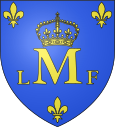Montargis
| Montargis | ||
|---|---|---|

|
|
|
| region | Center-Val de Loire | |
| Department | Loiret | |
| Arrondissement | Montargis | |
| Canton | Montargis (main town) | |
| Community association | Montargoise et Rives du Loing | |
| Coordinates | 48 ° 0 ′ N , 2 ° 44 ′ E | |
| height | 82-112 m | |
| surface | 4.46 km 2 | |
| Residents | 14,643 (January 1, 2017) | |
| Population density | 3,283 inhabitants / km 2 | |
| Post Code | 45200 | |
| INSEE code | 45208 | |
| Website | www.montargis.fr | |

|
||
Montargis is a city of 14,643 inhabitants (as of January 1, 2017) in France . It is the capital of the eponymous canton Montargis and administrative office ( sub-prefecture ) of the arrondissement of Montargis in the department of Loiret in the region Center-Val de Loire , on the river Loing and its tributaries Puiseaux and Vernisson .
geography
Montargis has had a train station on the Moret-Veneux-les-Sablons-Lyon-Perrache railway since 1860 . This is served by trains of the TER Center-Val de Loire on the Paris-Bercy - Nevers connection and is the end point for the Transilien from Paris-Gare-de-Lyon .
history
Joscelin de Courtenay (* 1034) built a castle in the 11th century in Courtenay in the arrondissement of Montargis and founded the city of Montargis.
Peter I (* 1126), who was a son of Ludwig VI. , King of France, married Elisabeth de Courtenay in 1150. He had to surrender the land that his wife brought into the marriage to the royal throne. He expanded the castle into an impregnable fortress. The inhabitants of Montargis resisted a siege by the English in 1427, which brought them legal privileges and thus great prosperity.
Around the year 1240 Amicia de Montfort founded a Dominican convent near Montargis. Well-known members of the convent were the English princess Eleanor and Blanchefleur, the illegitimate daughter of Emperor Frederick II. According to legend, in 1371 the divine judgment against Robert de Macaire took place in Montargis . The legend "The Dog of Montargis" only became better known through various sculptures in Montargis. One in the hall of the Salle de Fêtes, another in the forecourt of the Musée Girodet. Both show the scene when Macaire's dog, who alone witnessed the murder of his master, recognizes the murderer in a confrontation and jumps up on him. The murderer was then found to be convicted and arrested.
During the Reformation , the French king's daughter Renée de France , the widow of Ercole II. D'Este , returned to France from Ferrara and settled in her castle in Montargis. As a sympathizer of the Evangelicals, she supported them and until her death in 1574 during the Huguenot Wars they always housed between 300 and 460 refugees on their estate, including Catholics. Because she campaigned for a religious peace between the two denominations.
Henry IV. (France) left the ship channel Canal de Briare between Briare on the Loire and Montargis in the years 1604 to 1642 built. The Canal du Loing was built a century later in order to safely transport ships from Montargis to the Seine . A small side canal also flows out near Montargis, the Canal d'Orléans , which at the time established a connection with the Loire near Orléans , but is no longer navigable for ships today.
There was a French internment camp in Montargis after the outbreak of World War II .
Historic Buildings
- The Montargis Castle
- The 12th century church of Sainte-Madeleine
Personalities
- Renée de France (1510–1574), Duchess of Ferrara, lived in Montargis from 1560 to 1574
- Jeanne-Marie Bouvier de La Motte Guyon (1648–1717), mystic
- Jean-Pierre Nicéron (1685–1738), lexicographer and translator, lived in Montargis for ten years
- Anne-Louis Girodet-Trioson (1767–1824), Romantic painter
- Charles Étienne Gudin de La Sablonnière (1768–1812), infantry general
- Ulysse Trélat senior (1795–1879), doctor and politician, founder of Aide-toi, le ciel t'aidera
- Vincent Purkart (1936–2015), table tennis player
- Carole Sergent (* 1962), jazz singer
- Isabelle Duthoit (* 1970), jazz and improvisation musician
- Patricia Petibon (* 1970), soprano
Twin cities
- Greven , Germany (since 1968)
- Crowborough , Great Britain / East Sussex
Sports
Montargis was the destination of the 21st stage of the Tour de France 1969 and the start of the 21st stage of the Tour de France 1976 . In 2005, on July 6th, Montargis was again given special attention as the destination of the 5th stage of the Tour de France .
Montargis was a start and finish point of the Tour de France 2010 .
Canal du Loing , painted by Alfred Sisley
Web links
- Homepage of Montargis
- Historical postcards
- Gâtinais Histoire
- Les amis du vieux Montargis
- Visit to the cradle of Chinese communism at spiegel.de






